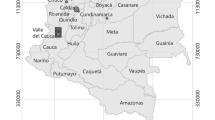Abstract
Purpose
The use of coal has declined owing to growing concerns regarding environmental pollution worldwide. Biomass is becoming a feasible alternative to coal, particularly for the continuous generation of agricultural biomass. However, the low heating value of biomass limits its widespread use. Torrefaction may help overcome the restriction of biomass. Methods: This study performed torrefaction on soybean husks, maize cobs, rice straw, pruned grape branches, wood pellets, and bamboo. Torrefaction was done at 230–310 ℃ for 30 or 60 min.
Results
The mass yield ranged from 35.62% to 93.59%, depending on the biomass type and process variables. The mass yield and severity factor were positively correlated with correlations ranging from 0.7074 to 0.9345. Moreover, the fuel properties changed, wherein mass loss, fixed carbon, and volatile matter changed slightly in the wood pellets. In contrast, increasing the treatment temperature and duration heightened the fixed carbon content and decreased the volatile matter content of the remaining biomass. Elemental analysis showed an increase in carbon content and a decrease in hydrogen and oxygen contents. Some torrefied biomasses have a low combustion index, which may make fuel usage difficult. Generally, enhancements in conventional biomass were evident.
Conclusion
This study demonstrated that the process of torrefaction led to improvements in biomass fuel properties.










Similar content being viewed by others
References
Bach, Q. V., & Skreiberg, O. (2016). Upgrading biomass fuels via wet torrefaction: A review and comparison with dry torrefaction. In Renewable and Sustainable Energy Reviews (Vol. 54, pp. 665–677). Elsevier Ltd. https://doi.org/10.1016/j.rser.2015.10.014
Basu, P. (2018). Biomass Gasification, Pyrolysis and Torrefaction: Practical Design and Theory (2nd edtion, Vol. 2nd). Academic Press.
Bisset V (2023). The U.N. warns ‘an era of global boiling’ has started. What does that mean? The Washington Post.
Cao, X., Luo, Q., Song, F., Liu, G., Chen, S., Li, Y., Li, X., & Lu, Y. (2023). Effects of oxidative torrefaction on the physicochemical properties and pyrolysis products of hemicellulose in bamboo processing residues. Industrial Crops and Products, 191. https://doi.org/10.1016/j.indcrop.2022.115986
Chen, D., Chen, F., Cen, K., Cao, X., Zhang, J., & Zhou, J. (2020). Upgrading rice husk via oxidative torrefaction: Characterization of solid, liquid, gaseous products and a comparison with non-oxidative torrefaction. Fuel, 275. https://doi.org/10.1016/j.fuel.2020.117936
Conag, A. T., Villahermosa, J. E. R., Cabatingan, L. K., & Go, A. W. (2018). Energy densification of sugarcane leaves through torrefaction under minimized oxidative atmosphere. Energy for Sustainable Development, 42, 160–169. https://doi.org/10.1016/j.esd.2017.11.004
Joshi, Y., Di Marcello, M., & De Jong, W. (2015). Torrefaction: Mechanistic study of constituent transformations in herbaceous biomass. Journal of Analytical and Applied Pyrolysis, 115, 353–361. https://doi.org/10.1016/j.jaap.2015.08.014
Kim, M. (2020). Bamboo is now used as a raw material for wood pellets. National Institute of Forest Science.
Kim, S., Lee, C., & Park, J. (2019). Evaluation of Fuel Quality for Solid Culm Bamboo from Myanmar by a Comparative Study. New & Renewable Energy, 15(4), 66–74. https://doi.org/10.7849/ksnre.2019.12.15.4.066
Lee, C. G., Lee, S. Y., Joo, S. Y., Cho, L. H., Park, S. Y., Lee, S. H., Oh, K. C., & Kim, D. H. (2017). A Study on Agricultural by-products for Biomass-to-energy Conversion and Korean Collecting Model. New & Renewable Energy, 13(1), 27–35. https://doi.org/10.7849/ksnre.2017.3.13.1.027
Lee, J. im, & Lee, S. eun. (2016). A Strategy for Agricultural Waste to Energy. Gyeonggi Yeonguwon.
Ma, Q., Han, L., & Huang, G. (2017). Evaluation of different water-washing treatments effects on wheat straw combustion properties. Bioresource Technology, 245, 1075–1083. https://doi.org/10.1016/j.biortech.2017.09.052
Park, S.-W., Yang, J.-K., & Baek, K.-R. (2013). Fuel ratio and combustion characteristics of torrefied biomass. Journal of Korea Society of Waste Management, 30(4), 376–382. https://doi.org/10.9786/kswm.2013.30.4.376
Prins, M. J., Ptasinski, K. J., & Janssen, F. J. J. G. (2006). More efficient biomass gasification via torrefaction. Energy, 31(15), 3458–3470. https://doi.org/10.1016/j.energy.2006.03.008
Resource map analysis system. (2023). Korea Institute of Energy Research. https://www.kier-solar.org/user/map.do?type=bm. Accessed 5 Jul 2023
Roberto, C. S., Jr., De Castro, P., Freitas, V. P., Yamaji, M. F., & De Almeida, R. A. (2016). PRODUCTION AND CHARACTERIZATION OF BAMBOO PELLETS. Bioscience Journal, 4, 922–930.
Singh, R. K., Sarkar, A., & Chakraborty, J. P. (2020). Effect of torrefaction on the physicochemical properties of eucalyptus derived biofuels: estimation of kinetic parameters and optimizing torrefaction using response surface methodology (RSM). Energy, 198. https://doi.org/10.1016/j.energy.2020.117369
Wang, C., Bi, H., Lin, Q., Jiang, C., Jiang, X., & Meng, K. (2021). Thermal Characteristics, Kinetics, and Volatility of Co-Combustion of Sewage Sludge and Rice Husk. Bioenergy Research, 14(3), 1014–1024. https://doi.org/10.1007/s12155-020-10203-x
Wood pellet production and sales. (2023). Korea Forest Service.
Yang, G., Kim, J., Darsan Purusatama, B., Fajar Suri, I., Prasetia, D., & Kim Namhun. (2021). Low Temperature Carbonization Characteristics of Bamboo and Wood. Korean Wood Engineering, 29–29. https://kiss.kstudy.com/Detail/Ar?key=3885285. Accessed 5 Jul 2023
Zhang, D., Han, P., Zheng, H., & Yan, Z. (2022). Torrefaction of walnut oil processing wastes by superheated steam: Effects on products characteristics. Science of the Total Environment, 830. https://doi.org/10.1016/j.scitotenv.2022.154649
Zheng, S., Hu, Y., Wang, Z., & Cheng, X. (2020). Experimental investigation on ignition and burnout characteristics of semi-coke and bituminous coal blends. Journal of the Energy Institute, 93(4), 1373–1381. https://doi.org/10.1016/j.joei.2019.12.007
Acknowledgements
This research was supported by Basic Science Research Program through the National Research Foundation of Korea (NRF) funded by the Ministry of Education(2021R1A6A1A0304424211).
Funding
This research was supported by Basic Science Research Program through the National Research Foundation of Korea(NRF) funded by the Ministry of Education(2021R1A6A1A0304424211).
Author information
Authors and Affiliations
Corresponding author
Ethics declarations
Competing Interest
The authors declare no competing interests.
Rights and permissions
Springer Nature or its licensor (e.g. a society or other partner) holds exclusive rights to this article under a publishing agreement with the author(s) or other rightsholder(s); author self-archiving of the accepted manuscript version of this article is solely governed by the terms of such publishing agreement and applicable law.
About this article
Cite this article
Park, S., Kim, S.J., Oh, K.C. et al. Utilising Torrefaction to Determine the Fuel Characteristics of Forestry and Agricultural Biomass for Solid Biofuel. J. Biosyst. Eng. (2024). https://doi.org/10.1007/s42853-024-00225-0
Received:
Revised:
Accepted:
Published:
DOI: https://doi.org/10.1007/s42853-024-00225-0




